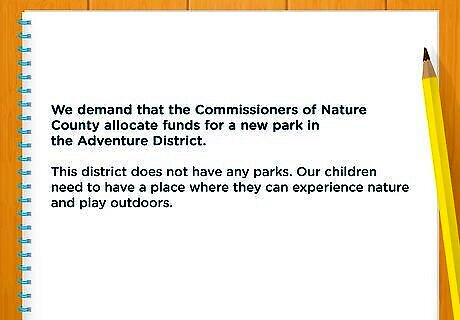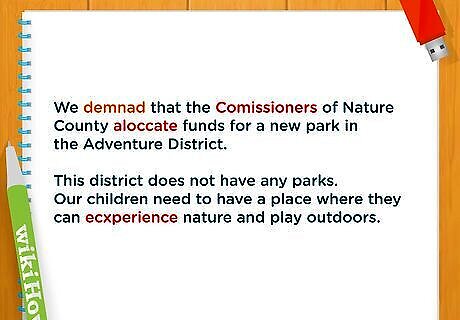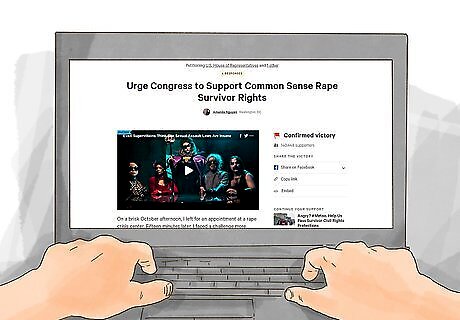
views
Formulating Your Request

Develop your argument. Before you start your petition, put some time into researching your topic thoroughly. Look at websites and literature about your cause. Get an idea of not only what you want to change, but what the counterpoints to your arguments might be. If, for example, you want to petition your local government for a new park, look on your town's website regarding regulations and rules for parks. See if you can find previous budgets or proposals for past parks, too.

Verify the jurisdiction for the petition. Think about who will have to implement the petition. Will it be a school, your office, your local government, or a national body? Contact administrative offices or check out the organization's website to make sure that they are the correct body for your petition. If you are petitioning a government office, have the office direct you to the department that handles matters related to your cause. Then request petition guidelines. You may also want to confirm whether or not your petition needs approval prior to circulating.

Find out how many signatures you need. Most government bodies and many other organizations have guidelines regarding the number of signatures required for a petition to be considered. Confirm this number with the group or agency where your petition will be submitted.

Develop a clear and specific statement of your goal. Once you know what is required of your petition, write a statement that frames your goals. It should be precise, concise, and informative. It doesn't need to contain every target or point for your cause, but it should give potential signers a strong idea of your cause. ”We support more funding for a park” is far too weak and general. Instead, try, “We demand that the Commissioners of Nature County allocate funds for a new park in the Adventure District.” This statement will go at the top of your petition. You may choose to put it in larger and/or bolded text to make it stand out.
Explaining Your Cause

Add a brief summary of your cause. Under your goal statement, include a paragraph or two that briefly describes the nature of the issue, a statement about why the issue matters to the petition audience, and a proposed change or call to action to address the issue. You want to describe the issue in a way that makes sense to someone even if they know nothing about the cause. The longer your petition is, the less likely people will be to read it through completely or sign it. Try keeping your petition's text to two or three short, easy to scan paragraphs. Adding a few bullet points or number can also he helpful. Do a check to make sure your petition text makes sense. Have someone else read it over to check for clarity and see if they understand your the problem and your campaign's end goal.

Prepare references for your statements. Some people will want to know where you are getting your information so that they can make sure it is valid. Prepare an additional sheet that you can keep behind your petition that cites the references you consulted. Be sure to include the title and author of the reference, where you found it (like a book title or URL, if applicable), and the date you accessed it. You can even choose to print out a few extra copies and hand them out if someone requests such.

Edit your petition for spelling and grammar errors. If errors litter your petition, it is very unlikely you will be taken seriously. Use spell check and proofread your petition for obvious mistakes. Read it out loud to determine if it flows and makes sense.
Calling People to Action

Make a call to action. Your opening statement may touch on what you want to see done about the issue, but you should also include a brief paragraph explaining the desired result. Let people know what will happen if your petition is fulfilled. Be concise, but specific. Let people know what you want to happen, who can make it happen, and when it should happen. Try something like, "we call on the Department of Housing and Economic Development to require at least 20% voucher-sponsored housing in all buildings in the city within the next five years."

Let people know what else they can do to support the cause. If applicable, you can choose to include a paragraph at the bottom of your petition letting people know if there are other things they can do to support your cause. If it would help to have people calling local political offices or setting up meetings with company heads, let people know who they should be talking to and how to get in touch with them. You could add on a brief statement like, "To further support the cause, make an appointment to meet with the City Manager's Office sometime before the City Council vote this coming March."

Create a signer's form on a separate sheet for paper petitions. The signer's form is the actual action you want from people, and you need a designated space for that. Put the petition title on top of the form. Then, use a spreadsheet or word processor to create signature and demographic lines. Depending on your cause and the requirements for a petition in your area, you may want to include email addresses, phone numbers, and zip codes along with names and signatures. Collect postal codes, zip codes, or any other information legally required so that you can verify the signers live in an area impacted by your petition issue. Print out more copies of the signature form than you think you'll need. It's always better to be over-prepared than to have to turn away impactful signatures. If you are using a website to collect signatures, the program will develop the signature form for you.
Promoting Your Petition

Talk to people in person. Go where you can speak with large numbers of people concerned about the issue or open to information about it. Go to public places in areas where your target audience likes to congregate or hang out to start collecting signatures. Spread the word about your petition through your office, school, and other social groups, and hand out signature forms to friends who may also want to get involved. If you want to speak or solicit on private property or closed campuses, including schools, make sure you get the necessary permission first. If there is a local rally or event scheduled regarding your petition issue, ask if you can make a quick speech there to get people to sign. Be polite when soliciting signatures in person. Even if someone believes in your cause, they might not have the time or ability to support you at the moment. It's always better to be polite. People may still contact you or help fund your cause later on.

Use e-mail to circulate online petition forms. Create an online version of your petition and send it to your family, friends, and acquaintances. Include your call to action and a brief statement about the petition in the body of the email. Then, provide a direct link to your online petition form. Try not to flood people with e-mails. Sending an e-mail every day will not get results. Instead, follow up a first round of petitions with 1-2 reminders over the period when you are petitioning.

Create an online presence for your petition. Create a blog or online forum where you can discuss your petition and answer the questions of potential signers. Media platforms like Facebook and Twitter are great ways to get the word out. In addition, building a blog or making a campaign page on a petition website will allow you to communicate updates to your signers. Use a designated hashtag that you develop specifically for your petition so that it is easy to track the attention your social media posts receive. Even if you're petitioning for a national cause, focusing on local media can help gather support in your area and draw attention from larger media sources.




















Comments
0 comment